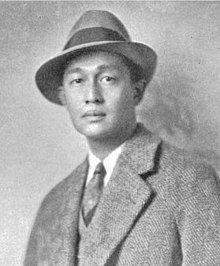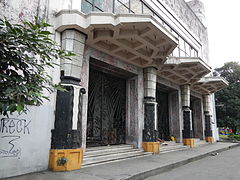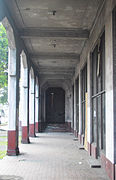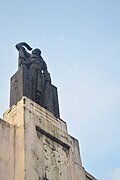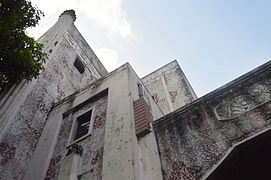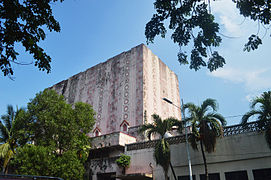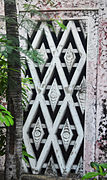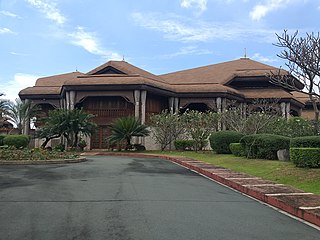
Coconut Palace, also known as Tahanang Pilipino, is a government building located in the Cultural Center of the Philippines Complex in Manila, Philippines. It was the official residence and the principal workplace of the vice president of the Philippines during the term of Jejomar Binay.

The Cultural Center of the Philippines Foundation, Inc. is a government-owned and controlled corporation established to preserve, develop and promote arts and culture in the Philippines. The CCP was established through Executive Order No. 30 s. 1966 by President Ferdinand Marcos. Although an independent institution of the Philippine government, it receives an annual subsidy and is placed under the National Commission for Culture and the Arts for purposes of policy coordination. The CCP is headed by an 11-member Board of Trustees, currently headed by Chairperson Margarita Moran-Floirendo. Its current president is Arsenio Lizaso.
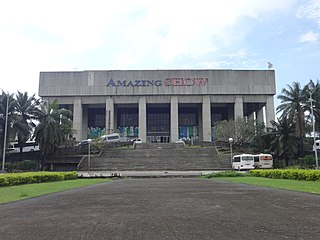
The Manila Film Center is a national building located at the southwest end of the Cultural Center of the Philippines Complex in Pasay, Philippines. The structure was designed by architect Froilan Hong where its edifice is supported on more than nine hundred piles which reaches to the bed-rock about 120 feet below.

Juan Marcos Arellano y de Guzmán, or Juan M. Arellano, was a Filipino architect, best known for Manila's Metropolitan Theater (1935), Legislative Building, the Manila Central Post Office Building (1926), the Rizal Memorial Sports Complex (1934), the Central Student Church, the old Jaro Municipal Hall (1934) and the Old Iloilo City Hall (1935) in Iloilo, the Negros Occidental Provincial Capitol (1936), the Cebu Provincial Capitol (1937), the Bank of the Philippine Islands Cebu Main Branch (1940), Misamis Occidental Provincial Capitol Building (1935), Cotabato Municipal Hall (1940) and the Jones Bridge during the pre-war era.
Jesus Tamayo Peralta is a painter, photographer, graphic artist, poet, anthropologist/archaeologist, essayist, and is also one of the prizewinning playwrights in the Philippines.

The Rizal Memorial Coliseum is an indoor arena in the Rizal Memorial Sports Complex in Manila, Philippines. It can hold up to 6,100 people.
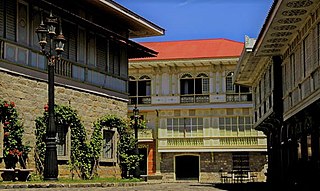
The architecture of the Philippines reflects the historical and cultural traditions in the country. Most prominent historic structures in the archipelago are influenced by Austronesian, American architectures.

Pablo Sebero Antonio, Sr. was a Filipino architect. A pioneer of modern Philippine architecture, he was recognized in some quarters as the foremost Filipino modernist architect of his time. The rank and title of National Artist of the Philippines was conferred on him by President Ferdinand Marcos in 1976.

The Manila Central Post Office, often called the Post Office Building, is the main postal office of Manila, which also serves as the headquarters of the Philippine Postal Corporation. It also houses the main mail sorting-distribution operations of the Philippines.

The Manila City Hall is the official seat of government of the City of Manila, located in the historic center of Ermita, Manila. It is where the Mayor of Manila holds office and the chambers of the Manila City Council is located. It was originally intended to be a part of a national government center envisioned by Daniel Burnham in the 1900s. Although the dream plan was not fully implemented, some buildings for the proposed government center were constructed, including the Old Legislative Building, and the Agriculture and Finance Buildings.

The Cebu Provincial Capitol is the seat of the provincial government of Cebu in the Philippines. Located at the north end of Osmeña Boulevard in Cebu City, it was designed by Juan M. Arellano, a Filipino architect best known for the Manila Metropolitan Theater (1935), the Legislative Building, and the Manila Central Post Office (1926). An inscription on the central concave portion of its façade reads, "The authority of the government emanates from the people. Erected A.D. MCMXXXVII."

The Manila Jai Alai Building was a building designed by American architects Welton Becket and Walter Wurdeman that functioned as a building for which jai alai games were held. It was built in the Streamline Moderne style in 1940 and survived the Battle of Manila. It was considered as the finest Art Deco building in Asia, until its demolition. It was demolished in 2000 upon the orders of the Mayor of Manila Lito Atienza amidst protests, to make way for the Manila Hall of Justice, which was never built.
The City of Man was a re-branding campaign aimed to improve the image of Manila, the capital of the Philippines. The name was in reference to a shortened version of the name of Manila, and the campaign was launched by the Governor of Metro Manila and then first lady of the Philippines Imelda Marcos to reshape the city with an eye to world tourism, commerce and economic power and development. Under her campaign, several urban projects were undertaken to make Manila the world's center of international tourism and finance.

The Philippine Institute of Architects (PIA) is an architectural society in the Philippines and is the oldest architectural society in Asia. It is composed of noble men and women from the architectural profession of the Philippines. It was founded by renowned architects in 1933 whose ultimate endeavor is the professional development of architecture in the Philippines.

Bellevue Theater is a small theater located in Paco district, Manila, Philippines. The theater adopted Philippine Islamic imagery as its art deco theme, borrowing inspiration from the tradition of moro-moro theatrical scenography.
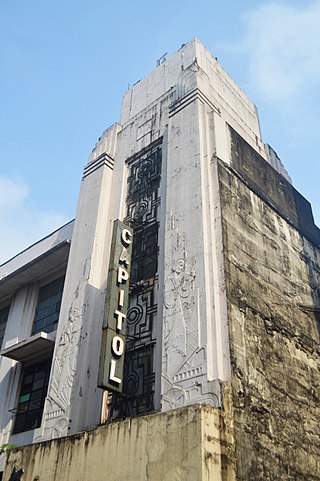
The Capitol Theater was an Art deco theater in Manila, Philippines. It was built during the 1930s along Escolta Street, part of the city's primary commercial district, together with the Lyric Theater. It was designed with a double-balcony by National Artist Juan Nakpil and that was considered a rare feat during that era.

The Cultural Center of the Philippines Complex, also known as the CCP Complex, is an 88-hectare (220-acre) art district managed by the Cultural Center of the Philippines (CCP) located along Roxas Boulevard in Metro Manila, Philippines. It is a mixed-use cultural and tourism hub overlooking Manila Bay in south-central Manila, most of which fall under the jurisdiction of the city of Pasay.

The Tanghalang Pambansa, formerly Theater of Performing Arts, is a theater located in the Cultural Center of the Philippines Complex in Manila, Philippines.
Pedro Siochi was a Philippine architect and civil engineer of famous landmarks in the Philippines.


